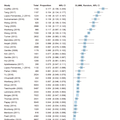Abstract
Background: Gaming disorder (GD) has been listed in the International Classification of Diseases 11th Revision. Studies on GD prevalence have been highly heterogeneous, and there are significant gaps in prevalence estimates. Few studies have examined what methodological and demographic factors could explain this phenomenon. Therefore, this meta-analytic study quantifies globally reported GD prevalence rates and explores their various moderating variables.
Methods: Prevalence estimates were extracted from 61 studies conducted before December 3, 2020, which included 227,665 participants across 29 countries. Subgroup and moderator analyses were used to investigate the potential causes of heterogeneity, including region, sample size, year of data collection, age group, study design, sampling method, survey format, sample type, risk of bias, terminology, assessment tool, and male proportion.
Results: The overall pooled prevalence of GD was 3.3% (95% confidence interval: 2.6–4.0) (8.5% in males and 3.5% in females). By selecting only 28 representative sample studies, the prevalence estimate was reduced to 2.4% (95% CI 1.7–3.2), and the adjusted prevalence estimate using the trim-and-fill method was 1.4% (95% CI 0.9–1.9). High heterogeneity in GD prevalence rates was influenced by various moderators, such as participant variables (e.g., region, sample size, and age) and study methodology (e.g., study design, sampling method, sample type, terminology, and instrument). The moderator analyses revealed that the sample size, mean age, and study quality were negatively associated with GD prevalence.
Conclusions: This study confirms that GD prevalence studies were highly heterogeneous based on participant demographics and research methodologies. Various confounding variables, such as sampling methods, sample types, assessment tools, age, region, and cultural factors have significantly influenced the GD prevalence rates. Prevalence estimates are likely to vary depending on study quality. Further epidemiological studies should be conducted using rigorous methodological standards to more accurately estimate GD prevalence.
